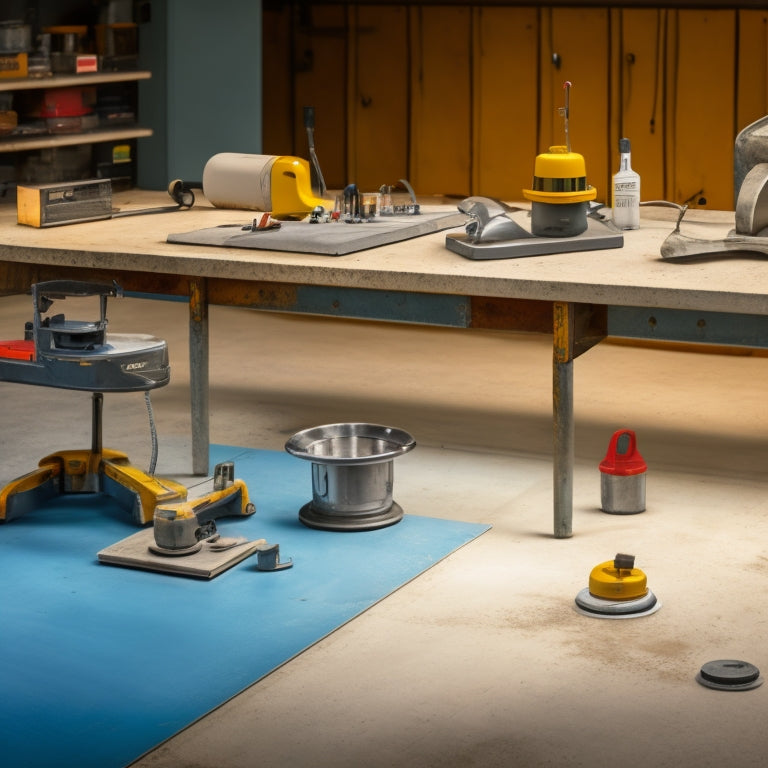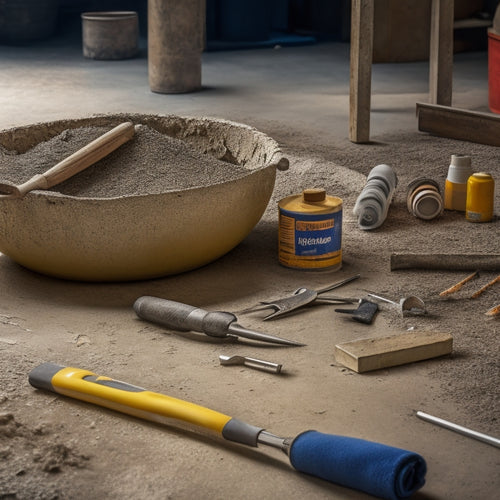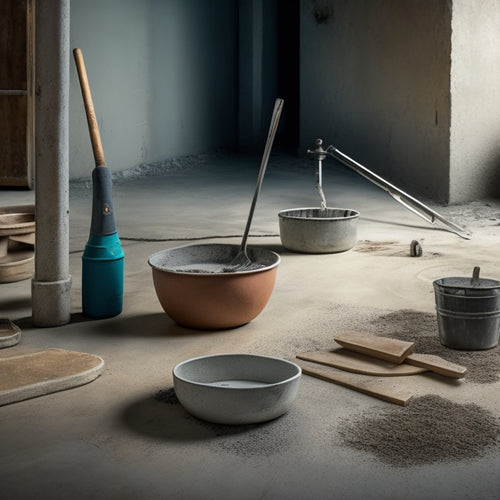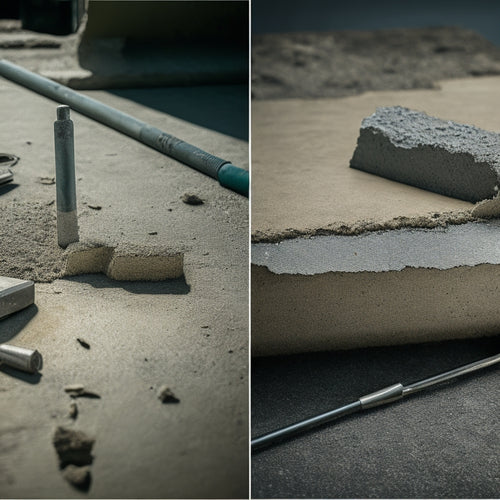
Selecting the Right Polishing Tools for Concrete
Share
When selecting the right polishing tools for your concrete project, you'll need to evaluate the level of polish required, assess the surface condition, and choose between wet and dry techniques. The tool's size, type, and diamond quality also impact the final result. Verify the tools are compatible with your equipment and prioritize safety features to minimize injury risk. By understanding these factors, you can optimize your polishing process. As you continue to refine your approach, you'll be able to access the full potential of your concrete polishing project and achieve a finish that exceeds your expectations.
Key Takeaways
• Choose polishing tools based on the desired finish, concrete type, and project size to ensure effective results and efficient workflow.
• Evaluate diamond tool quality, considering material durability, consistent diamond grit size, and matrix material cooling efficiency for optimal performance.
• Select tools with compatible arbor sizes and thread types to ensure seamless operation with grinders or polishers, and consider motor speed and horsepower.
• Prioritize tools with built-in safety features, such as dust containment systems, ergonomic grips, and adjustable handles, to minimize injury risk and enhance comfort.
• Consider the trade-off between tool cost and long-term benefits, including efficiency, maintenance, and potential cost savings, when selecting polishing tools.
Determine Polishing Level Needed
When planning a concrete polishing project, you must first determine the desired level of polish, as this will dictate the type of equipment, tools, and techniques required to achieve the desired finish. This vital step will guide your entire project, making sure you use the right tools and techniques to achieve the desired outcome.
You'll need to evaluate the level of sheen, reflectivity, and clarity you want to achieve. Do you want a high-gloss finish or a more matte appearance? This will influence your polishing techniques and the type of equipment you'll need. For instance, a high-gloss finish will require more aggressive polishing techniques and specialized equipment, while a matte finish may only need a light polishing.
Proper surface preparation is also essential to achieving the desired polish level. This includes confirming the concrete is clean, dry, and free of imperfections. You may need to repair cracks or fill in divots before beginning the polishing process.
Assess Concrete Surface Condition
How accurately can you assess the surface condition of your concrete, considering factors like scratches, cracks, and porosity, to determine the most effective polishing strategy? A thorough assessment is vital in identifying surface imperfections that may impact the polishing process.
Take a close look at the concrete textures, noting any variations in roughness, smoothness, or unevenness. Check for cracks, scratches, and other defects that may require special attention or repair before polishing.
When evaluating the surface condition, consider the porosity of the concrete, as it can affect the polishing process. High-porosity concrete may require more aggressive polishing, while low-porosity concrete may need a gentler approach.
Take note of any existing coatings, sealers, or toppings that may need to be removed before polishing. A detailed assessment of the surface condition will help you choose the right polishing tools and develop an effective strategy to achieve the desired level of shine and durability.
Choose Between Wet and Dry
When selecting a polishing method for your concrete project, you'll need to decide between wet and dry polishing.
You should consider the specific requirements of your job, including the type of concrete, desired finish, and environmental concerns, to determine which approach is best.
Wet Polishing Methods
You'll typically choose wet polishing methods for concrete surfaces that require a high-gloss finish, as they effectively remove scratches and imperfections while producing a reflective shine. Wet polishing involves using water to cool the polishing tools and remove residue, resulting in a higher-quality finish. This method is ideal for surfaces that require a high level of reflectivity, such as floors in retail or commercial spaces.
When using wet polishing methods, it is crucial to take into account water usage and slurry management. You'll need to verify that you have a sufficient water supply and a plan in place for disposing of the slurry generated during the polishing process.
Here's a breakdown of the key considerations for wet polishing methods:
| Factor | Consideration | Impact |
|---|---|---|
| Water Usage | Confirm sufficient water supply | Affects polishing quality and tool lifespan |
| Slurry Management | Plan for slurry disposal | Affects job site cleanliness and environmental impact |
| Tool Selection | Choose tools designed for wet polishing | Affects polishing quality and tool lifespan |
Dry Polishing Benefits
Opting for dry polishing methods can be a strategic decision, especially when working on concrete surfaces that don't require a high-gloss finish or when water conservation is a priority.
By choosing dry polishing, you'll eliminate the need for water, which reduces the risk of slippery floors and makes the work area safer. Additionally, dry polishing methods provide better dust control, as the dust is captured by the polishing tool or vacuum system, rather than being dispersed into the air.
Dry polishing also allows for more flexibility regarding the surface finish you can achieve. With the right tools and techniques, you can produce a high-quality, matte finish that's perfect for industrial or commercial applications.
Moreover, dry polishing tools are often lighter and more maneuverable than their wet counterparts, making them easier to handle and reducing operator fatigue.
Consider Tool Size and Type
Your concrete polishing project's success hinges on selecting the right tool size and type, as they greatly impact the quality of the finished surface and the efficiency of the process.
When choosing a tool, consider its weight and maneuverability. A tool that's too heavy can be difficult to handle, leading to operator fatigue and decreased productivity. On the other hand, a tool that's too light may not provide enough pressure to effectively polish the concrete. Opt for a tool that strikes a balance between weight and maneuverability, ensuring you can easily navigate tight spaces and maintain control.
Additionally, consider the type of tool you need. Are you working on a large, open area or a small, confined space? Do you need a tool with a high torque output or one with a slower, more precise speed?
The right tool type will depend on the specific demands of your project. By selecting a tool that's the right size and type, you'll be able to achieve a high-quality finish while maintaining a safe and efficient work environment.
Evaluate Diamond Tool Quality
When evaluating diamond tool quality, you'll want to examine the material quality of the tool itself, as it directly impacts its performance and lifespan.
You should also inspect the design of the diamond segments, which can greatly affect the tool's aggressiveness, cooling efficiency, and overall effectiveness.
Tool Material Quality
You must carefully evaluate the quality of diamond tools, as it directly impacts the effectiveness and efficiency of your concrete polishing process.
The tool's material quality is vital, as it affects tool durability and performance. When selecting diamond tools, you should consider the material types used in their construction. High-quality tools typically feature durable materials that can withstand the rigors of concrete polishing.
Look for tools with metal bonds made from high-strength materials, such as steel or tungsten carbide, which provide excellent wear resistance. The diamond grit itself should be of high quality, with a consistent size and shape to guarantee even cutting action.
Additionally, the tool's matrix material should be designed to effectively cool the diamonds and prevent overheating. By choosing tools with high-quality materials, you can guarantee a longer tool life, reduced maintenance, and improved polishing results.
Diamond Segment Design
The diamond segment design of a polishing tool greatly impacts its performance, as it directly affects the exposure and distribution of diamonds, which in turn influence the tool's cutting speed and aggressiveness. As you evaluate diamond tool quality, consider the segment shape and diamond grit type. The segment shape determines the tool's ability to reach into corners and edges, while the diamond grit type affects the tool's cutting speed and surface finish.
| Segment Shape | Description |
|---|---|
| Round | Ideal for curved surfaces and corner work |
| Square | Suitable for flat surfaces and edges |
| Triangle | Effective for corners and tight spaces |
| Hexagon | Combines the benefits of round and square shapes |
| Custom | Designed for specific applications and surfaces |
When selecting a polishing tool, consider the specific demands of your project. For example, if you're working on a curved surface, a round segment shape with a coarse diamond grit type may be the best choice. By understanding the diamond segment design, you can choose the right tool for your concrete polishing project, ensuring a safe and efficient process.
Check Tool Compatibility Options
Compatibility checks involve verifying your polishing tools can effectively interface with the concrete surface, other tools, and equipment to achieve ideal results.
When evaluating tool compatibility, you'll want to take into account the type of concrete you're working with, as well as the specific polishing task at hand. For instance, if you're working with a highly porous concrete, you may require a tool with a more aggressive diamond segment design to effectively remove imperfections.
To optimize polishing efficiency, make sure that your tools are compatible with your polishing equipment, such as grinders or polishers.
Check that the tool's arbor size and thread type match your equipment's specifications to prevent damage or safety hazards. Additionally, take into account the tool's motor speed and horsepower requirements to guarantee seamless operation.
Review Safety and Ergonomic Features
When selecting polishing tools for concrete, prioritize those with built-in safety features and ergonomic design to minimize operator fatigue and risk of injury. You want to confirm that the tools you choose won't put your health and well-being at risk.
Look for features such as ergonomic grips, which reduce strain on your hands and wrists, allowing you to work for longer periods without discomfort. Safety features like dust containment systems, which prevent the spread of hazardous concrete dust, are also essential.
Additionally, consider tools with adjustable handles or grips that fit comfortably in your hand, reducing the likelihood of accidents caused by slipping or losing control. Some polishing tools may also have safety features like overload protection, which prevents motor damage and reduces the risk of electrical shock.
Set a Budget and Timeline
You're now ready to allocate resources, so determine how much you're willing to spend on polishing tools and establish a realistic timeline for completing the project.
This vital step guarantees you stay within budget constraints and complete the job on time. Take into account the cost of equipment, consumables, and labor when setting your budget.
Be realistic about the time required for each stage of the process, from preparation to final polishing.
Remember to build in timeline flexibility to account for unexpected delays or setbacks. A well-planned schedule will help you manage your resources effectively and avoid costly overruns.
It's also essential to evaluate the long-term benefits of investing in high-quality polishing tools, such as increased efficiency and reduced maintenance costs.
Frequently Asked Questions
Can I Use the Same Polishing Tools for Different Concrete Mixes?
When working with different concrete mixes, you're right to wonder if you can reuse the same polishing tools.
However, it's essential to take into account concrete mix compatibility and polishing tool versatility.
While some tools may be adaptable, others mightn't perform at their best or even compromise your safety.
Be cautious and assess the tool's specifications before switching between mixes to guarantee a smooth, safe, and successful polishing process.
Do I Need to Clean My Polishing Tools After Each Use?
You must prioritize tool maintenance by cleaning your polishing tools after each use to guarantee peak performance and prevent damage.
Develop a routine of cleaning techniques, such as washing with mild soap and water, to remove residue and debris.
Failing to do so can lead to premature wear, reduced effectiveness, and even safety hazards.
Are Polishing Tools Compatible With All Concrete Sealers?
When working with concrete sealers, you'll want to guarantee your polishing tools are compatible to avoid damaging the sealer or the tool itself.
Not all tools are created equal; some materials, like metal, can react with certain sealers, causing damage or discoloration.
You'll need to check the tool material and sealer compatibility before use.
Always consult the manufacturer's guidelines to guarantee a safe and effective polishing process.
How Often Should I Replace My Polishing Tool's Diamond Segments?
'An ounce of prevention is worth a pound of cure.'
You know it's time to replace your polishing tool's diamond segments when they show signs of wear, such as reduced cutting efficiency or excessive dust production.
Regularly inspect your tools and maintain them properly to extend their diamond segment lifespan. Aim to replace them every 3-6 months, depending on usage and concrete type.
Proper polishing tool maintenance guarantees your safety and best results.
Can Polishing Tools Be Used on Non-Concrete Surfaces Like Granite?
When you're considering polishing tools for non-concrete surfaces like granite, you need to think about surface compatibility. Not all polishing tools are created equal, and using the wrong one can damage the surface or even put you at risk.
You'll want to choose a tool specifically designed for granite polishing, as it'll be engineered to handle the unique characteristics of this hard, dense stone.
Conclusion
As you navigate the polishing process, remember that having the right tools is the key to accessing a high-gloss finish.
Don't be stuck between a rock and a hard place - choose wisely, and your concrete will shine like a diamond.
With a clear understanding of your project's needs, you'll be well on your way to achieving a flawless finish that's sure to impress.
Related Posts
-

Top Tools for Repairing Cracked Concrete Surfaces
When tackling a cracked concrete surface repair, you'll need the right tools to guarantee a durable fix. Start with e...
-

Why You Need These Concrete Overlay Tools
When tackling a concrete overlay project, you need the right tools to achieve a flawless finish and avoid costly mist...
-

Top Tools for Concrete Adhesion Success
When it comes to concrete adhesion success, you'll need to wield the right tools and techniques to guarantee a strong...


